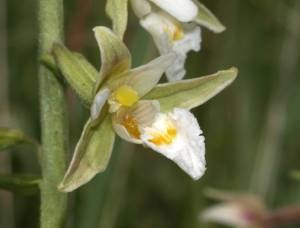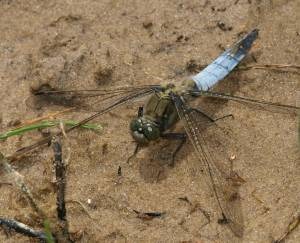Dr Phil Smith’s Wildlife Notes
July 2008
I always reckon to see some thing new and different every time I go out on the dunes. That was certainly the case on 7th July when I visited a local pond to record dragonflies for the Atlas survey. Approaching cautiously so as not to disturb anything, I was amazed to see a Stoat playing in the water. It was behaving just like an Otter, swimming and cavorting around, jumping in and out of the pond and clearly enjoying itself, until it eventually spotted me and disappeared.
Plentiful rainfall during the month encouraged the dune plants, especially the later-flowering orchids, like the Marsh Helleborine (Epipactis palustris). Many slacks along the coast were a stunning vista of wall-to-wall helleborines, and I was also delighted to find two small colonies of the rare white variety ochroleuca at Birkdale. Similarly, the pink Pyramidal Orchid (Anacamptis pyramidalis) has done remarkably well this year. It used to be quite hard to find on the dunes but, following a national trend probably linked to climate change, populations of this mainly southern plant have boomed in recent years. On 6th July, I tried to count the flower spikes on Ainsdale Sandhills but gave up at 860. Then I heard there was another big colony at Cabin Hill. In two visits a few days later, I reached an incredible total of 4872 Pyramidal Orchids. I must have missed plenty, so the true population is certainly over 5000! For the first time ever, I also found about a dozen white specimens, the flower books saying that this form is rarely seen.

While criss-crossing the dunes, I also encountered several Dark Green Fritillaries, our rarest coastal butterfly and also the fastest flying. This species occurs most frequently on Ainsdale National Nature Reserve and I couldn’t remember having seen it at Cabin Hill before. Its caterpillars feed on Heath Dog-violet (Viola canina) and there is certainly plenty of that at Cabin Hill. However, apart from the ubiquitous Meadow Browns, butterfly numbers were generally disappointing during the month, a reflection of the second wet summer in succession. The sun-loving dragonflies have also suffered, though on the occasional warm day, our largest species, the Emperor, could be seen cruising the dune scrapes at Birkdale and elsewhere. A relatively new arrival on the coast, the Black-tailed Skimmer, also made an appearance with three together at Cabin Hill.

July is a month when bird-watchers begin to think about the autumn migration. Breeding has largely finished and many species are already on the move, small flocks of terns being a feature of the quieter stretches of beach, as at Birkdale. The gale that affected the Open Championship at Royal Birkdale brought lots of Manx Shearwaters and Gannets and several Skuas (Arctic and Great) into Liverpool Bay. These could be seen from the usual sea-watching spots at Formby Point and Crosby. Even better were the Storm Petrels which began to appear off Formby on the 16th July, peaking at a remarkable 26 in the Mersey mouth at Crosby on 18th. A single Leach’s Petrel was also reported, this being usually a highlight of later storms in September or October.
